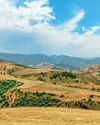
A yellow cloth flutters in the line of mangroves along the shore. Behind the trees, tall buildings shimmer in a haze of pollution; in front of them, thousands of flamingos are gathering, flying in from nearby roosting sites. As the sun ascends, the tidal water ebbs, exposing the mudflats that are the flamingos' feeding grounds.
The army of pink advances.
In a boat, Mrugank Prabhu unpacks his camera, sets up his telescope, and begins his count.
Prabhu is a scientist with the Bombay Natural History Society (BNHS), which is leading an ambitious 10-yearlong study to monitor a unique phenomenon. Every winter, thousands of greater and lesser flamingos fly into Mumbai, forming a sea of pink against a backdrop of skyscrapers, bridges and oil refineries along the 26-kilometerlong Thane Creek. The seasonal gathering is a source of wonder in Mumbai, and also a bit of a mystery.
The flamingos only began visiting Mumbai in significant numbers in the 1990s. As the city grew in the 1970s and '80s, so did the volume of untreated sewage flowing into Thane Creek, nurturing the algae that are the flamingos' main food, and turning the area into a feeding ground for the birds. Their numbers have increased in the past two decades, from at least 10,000 in 2007 to an estimated 1,30,000 this year.
The phenomenon illustrates the complexity of urban coastal ecosystems in India, say experts. Sometimes, "human impact results in conditions that seem terrible for nature at a glance, but are actually a gold mine for some species," says Sunjoy Monga, a veteran local naturalist, who has also led a study on Mumbai wildlife. Now, the flamingos are reshaping the ecological mindset of the city too, showing what wildlife can do for conservation even in the most pressured environments.
This story is from the {{IssueName}} edition of {{MagazineName}}.
Start your 7-day Magzter GOLD free trial to access thousands of curated premium stories, and 9,000+ magazines and newspapers.
Already a subscriber ? Sign In
This story is from the {{IssueName}} edition of {{MagazineName}}.
Start your 7-day Magzter GOLD free trial to access thousands of curated premium stories, and 9,000+ magazines and newspapers.
Already a subscriber? Sign In

Demonstrators by Krishna Reddy
1968 Multicolour viscosity, Print on paper

Notes from Grief Camp
Every summer, more than a hundred children come together to spend a weekend swimming, climbing and canoeing. They also learn to deal with death

Six Places Cheese Lovers Should Visit
Ancient caves, monasteries, and other must-sees for fromage fans

THE LAND OF SUPERCEN TENARIANS
A remote region of Azerbaijan claims to have many extremely long-lived residents. What is their secret, or is it just a myth?

The Whistle Blowers
My grandparents had a distinctive way of communicating

"THE NEXT AIRCRAFT WILL CRASH ON LANDING"
THE JET WAS ALMOST OUT OF FUEL. THE PILOTS' ONLY OPTION WAS A MANOEUVRE NO ONE HAD EVER ATTEMPTED.

The Secrets in our Genes
Genomic sequencing tests can reveal much about your unique physiology. But are they worth it?

GOOD NEWS FROM AROUND THE WORLD
MENTAL HEALTH When her son was arrested last year, Tambudzai Tembo's mind went to dark thoughts of suicide.

Into the Inferno
A gas station owner has seconds to react when a car crashes into a gas pump

THE CLIMATE CHANGERS
THESE PLACES ARE LEADING THE WAY TO A FUTURE FREE OF FOSSIL FUELS